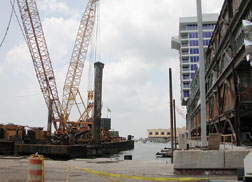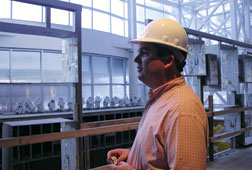...company back from higher production is “time in a day and people to manage forms.”
Reconstruction has contractors moving at breakneck speed. A project like the Bay Saint Louis Bridge would normally take up to five years, after planning, Nelson says. This one is going from demolition to completion in three. “I think we’re setting a new land-speed record,” he says. “I have to give credit to MDOT and the state for getting it back on track so fast.”
Despite the speedy work, not everyone is satisfied with the pace. “They should have started immediately after the storm with bridge construction, but I suppose there were so many issues that needed to be worked through to build the right bridge that took a little extra time,” says Rich Westfall, director of community development for the Isle of Capri Casino, on the eastern tip of Biloxi.
Casinos are the economic engine of the Mississippi coast, and the flow of gamblers through their doors depends on bridges and transportation. The Isle of Capri sits at the western foot of what used to be the U.S. 90 Bridge over Biloxi Bay. “About 75 to 80% of our guests came across that bridge,” Westfall says. “We drew from Mobile, Pensacola, up to Montgomery, Birmingham, the whole eastern seaboard and northwest Florida.”
Although the bridge isn’t set to start taking traffic for more than a year, coastal casinos are still connected to the mainland by I-110, and traffic is flowing. And while many of the coast’s casinos were damaged or destroyed, seven have re-opened. The Isle of Capri employed 1,100 people before the storm, and although it lost its floating barge casino and more than half its 750 hotel rooms, it reconfigured what was left and reopened at the end of last year. “We recognized the need to get open and get as many people back to work as quickly as possible,” Westfall says.
The Isle’s main competitor, Beau Rivage, reopened Aug. 29, at the foot of I-110, the primary access to the beach. Westfall is worried his clientele will be siphoned off and he aches for swift completion of the U.S. 90 bridge over Biloxi Bay. “It’s a lifeline,” Westfall says. It will be more than a year before the first two lanes are open, and the Isle is still eating the cost of building a new casino.
 |
Off the record, contractors say they could have rebuilt casinos quicker, but owners are dealing with the same issues over insurance claims that are plaguing business and home owners throughout the region. Companies like Gulf Coast Pre-Stress are not immune, either.
“We probably had $4 million of non-insurable losses,” Spruill says. “Plus, like everyone, we are still waiting to get paid for our insurable losses.” Meanwhile, premiums have tripled and there are new limits on coverage. “Now, instead of $23 million of equipment coverage, I have $5 million,” Spruill says. “The rest, I’ve got to make up.”
 |
| Battered. Hard Rock casino barge, above, is being rebuilt on piles. (Photo above right courtesy of Roy Anderson Corp, this photo and right below by Angelle Bergeron for ENR) |
Biloxi’s Hard Rock Casino is one casino receiving piles from Spruill’s operation. It was originally scheduled to open on Sunday, Aug. 28, 2005, at midnight, which was about when Katrina came ashore (ENR 9/26/05 p. 14). It was obliterated. Now the owners are planning a new opening July 2007.
“This owner wants to open the whole property 100%,” says Chuck Dudenhefer, project manager for Roy Anderson Corp., the Gulfport contractor that completed the original and now has a $75-million contract to rebuild the garage, part of the hotel, a low rise entertainment structure and a new casino. The night Katrina came to call, “the Hard Rock Café was done,” Dudenhefer says.
 |
| Chuck Dudenhefer: “Eighteen months of our efforts had been destroyed in one morning". |
“The building is designed for 140-mph winds, but not for a 3,000-ton barge to bump into it,” Dudenhefer says. The surge tore the barge loose and hammered it against the back of the building. RAC is constructing the new, pile-founded casino in the footprint of the old barge. Boh Bros. Construction Co., New Orleans, is working 24 hours a day to drive 18-in., 94-ft-long precast piles fabricated at GCP. “The critical path is getting the foundation in,” says Dudenhefer.
Dudenhefer returned two weeks after the storm. “Eighteen months of our efforts had been destroyed in one morning,” he says. Like a proud parent, he shows a photograph, taken the day before the grand opening. “See?” he says, “Mustard and ketchup on the tables.”

Post a comment to this article
Report Abusive Comment